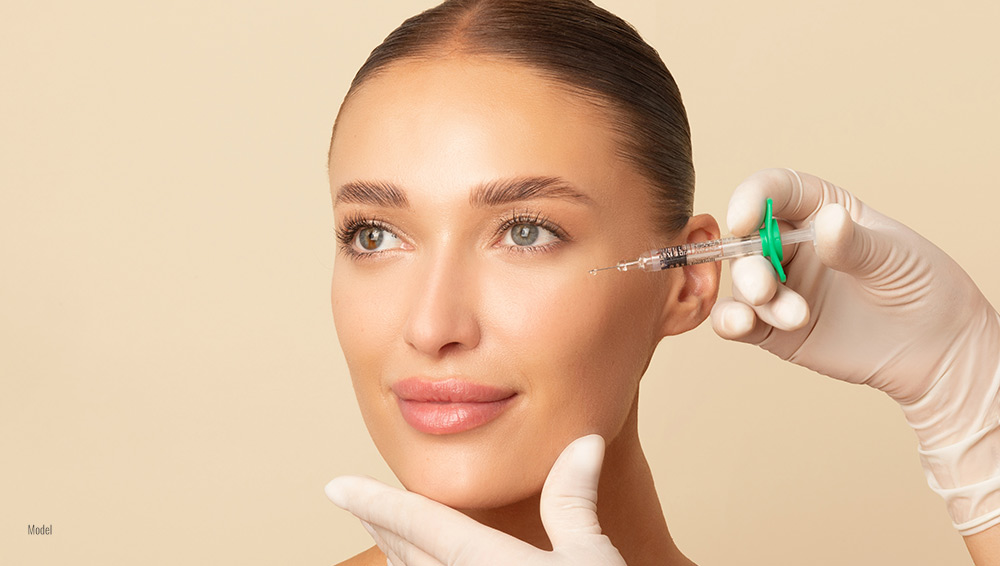What Are the Differences Between BOTOX® Cosmetic and Dysport®?
Posted September 19, 2024 in BOTOX® Cosmetic, Dysport®

Many people think that neuromodulators like BOTOX® Cosmetic and Dysport® are the same because they both utilize a similar main ingredient. However, because there are just enough variations in the two treatments, which one you choose may impact your results. In this blog, we explore the differences between BOTOX® Cosmetic and Dysport® so you have a better idea of which one will offer the best results for you.
4 Min Read:
How Do BOTOX® Cosmetic and Dysport® Work?
BOTOX® Cosmetic and Dysport® are neuromodulators, meaning that they affect how nerve impulses are transmitted. When used to smooth out wrinkles in your forehead and around your eyes, these neuromodulators block the nerve transmissions that signal the release of acetylcholine. Acetylcholine tells your brow to crease or your eyes to crinkle. By temporarily inhibiting these nerve impulses and the associated chemical release, your muscles don’t contract, and your skin remains smooth.
BOTOX® Cosmetic and Dysport® are both botulinum toxin A, derived from Clostridium botulinum bacteria. And while they are very similar, there are also a few key differences that may determine which one will offer the results you desire.
How Are BOTOX® Cosmetic and Dysport® Different?
Composition of the Injection
As mentioned above, BOTOX® Cosmetic and Dysport® are formulated from the same botulinum toxin. However, they differ in two specific areas: molecule size and protein load. BOTOX® Cosmetic contains larger molecules than Dysport® and carries a larger protein load.
The smaller molecules of Dysport® allow it to spread more easily, giving it the advantage of efficiently treating a larger area. However, the ease of diffusion can also cause the injectable to spread, making it less precise. The larger molecules of BOTOX® Cosmetic means it spreads less, making it a better choice for smaller treatment areas and areas (like around the eyes) that require more precision.
BOTOX® Cosmetic has a higher protein load than Dysport®, meaning that it prompts your body to produce more antibodies than it would with a lower protein load. The more antibodies produced, the quicker BOTOX® Cosmetic is metabolized, which means it may not last as long as you’d like. Because of its smaller protein load, Dysport® may last longer than BOTOX® Cosmetic.
Onset of Results
After your BOTOX® Cosmetic injections, you can expect to see some of the effects of your treatment within about three to five days, while initial Dysport® results are typically visible in two to four days. The full results of BOTOX® Cosmetic and Dysport® are typically evident around the ten to fourteen day mark.
Longevity of Results
BOTOX® Cosmetic and Dysport® both generally last for three to four months, though the longevity of results varies by patient. How long your results last depends on the area treated, dosage, and how quickly your body metabolizes the injection.
Dosage
Both BOTOX® Cosmetic and Dysport® doses are measured in units; however, their units are not the same. It can take up to three times the amount of Dysport® to achieve similar results to BOTOX® Cosmetic. This doesn’t mean that Dysport® is less potent than BOTOX® Cosmetic; it simply reflects the difference in their formulations and molecule size.
Cost
BOTOX® Cosmetic tends to cost a bit more than Dysport®; however, since it can take more units of Dysport® to achieve what BOTOX® Cosmetic can do with fewer units, the cost may balance out.
Applications Outside of Wrinkle-Smoothing
BOTOX® was originally discovered by ophthalmologists in the 1970s who were using botulinum toxin A injections to treat crossed eyes in patients. During testing, it was found that the neurotoxin also smoothed out glabellar lines (the lines between your eyes). BOTOX® Cosmetic was FDA-approved for cosmetic use in 2002. Over the years, BOTOX® has been FDA-approved for several therapeutic purposes, including excessive sweating (hyperhidrosis), cervical dystonia (neck spasms), chronic migraines, bladder problems, and, of course, eye conditions.
Dysport® was FDA-approved for cosmetic use in 2009, and while it is also approved to treat cervical dystonia, it is not yet cleared for as many other uses as BOTOX® and BOTOX® Cosmetic.
How Do I Choose Between BOTOX® Cosmetic or Dysport®?
There are several ways to decide whether BOTOX® Cosmetic or Dysport® is the right choice for you. Think about your treatment goals, cost considerations, and satisfaction with past experiences. If you’ve gotten BOTOX® Cosmetic or Dysport® before and were happy with the results, you may wish to stick with what works. It is also vital to take into account the recommendation of your provider—make sure you choose a highly trained and experienced injector to ensure the absolute best results.
Learn More About BOTOX® Cosmetic in Fresno
When you want to smooth out pesky forehead lines or crinkly crow’s feet around your eyes, it’s time to discover what BOTOX® Cosmetic can do. Board-certified plastic surgeon Dr. Mark Chin will assess your skin and offer recommendations for addressing your concerns. To schedule a consultation, call us today at (559) 435-9646 or complete the online contact form.